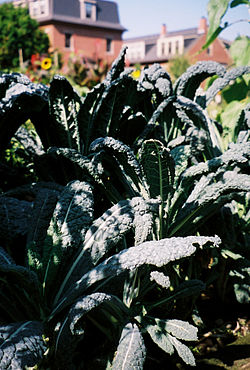- Lacinato kale
-
Lacinato kale is a variety of kale with a long tradition in Italian cuisine, especially that of Campania (although the term "lacinato" is not widely known or used in Italy). It is also known as Tuscan kale, Tuscan cabbage, Dinosaur kale, cavolo nero, black kale, flat back cabbage, palm tree kale, or black Tuscan palm.[1][2] Lacinato kale has been grown in Campania for centuries, and dishes with this kale predate the classic pasta and pizza dishes of the region.[3] It is one of the traditional ingredients of minestrone.[4]
Contents
Description
Lacinato kale has dark blue-green leaves, with an "embossed texture"; its taste is described as "slightly sweeter and more delicate ... than curly kale."[5] Because of its taste, "slightly bitter [and] earthy",[6] it has been called "the darling of the culinary world".[7]
Preparation and dishes
Lacinato kale, like most other kale varieties, is usually blanched first, and then sautéed with other, flavorful ingredients; in Campanian cuisine, anchovies are often added.[3] It is commonly used in pastas and soups, but can also be eaten raw, in a salad.[8]
In Tuscan cuisine, lacinato kale is often used in ribollita ("twice cooked"), a thick, hearty soup made up of ingredients cooked for a meal the day before.[9]
Cultivation
Lacinato kale is an heirloom plant, and dates to the 18th century in Italy.[10] This cultivar is popular among gardeners because of its color and texture,[10][11] and was listed amongst the plants Thomas Jefferson recorded in his 1777 garden at Monticello.[12] The plant grows to a height of two feet, with blistered leaves often over one foot in length each and two to four inches wide.[10] The "straplike"[13] leaves are typically harvested from the bottom of the stem, leaving the remainder of the plant looking like a palm tree.[10]
References
- ^ Goin, Suzanne; Gelber, Teri (2005). Sunday Suppers at Lucques: Seasonal Recipes from Market to Table. Random House Digital, Inc.. p. 236. http://books.google.com/books?id=F8i3E4emYJIC&lpg=PT236&dq=cavolo%20nero%20lacinato%20kale&pg=PT236#v=onepage&q=cavolo%20nero%20lacinato%20kale&f=false.
- ^ Thorness, Bill (2009). Edible Heirlooms: Heritage Vegetables for the Maritime Garden. Skipstone. p. 90. ISBN 978-1-59485-142-1. http://books.google.com/books?id=xCobUshBhpoC&lpg=PA90&dq=lacinato%20kale%20gardening&pg=PA90#v=onepage&q=lacinato%20kale%20gardening&f=false.
- ^ a b Appleman, Nate; Lindgren, Shelley; Leahy, Kate (2008). A16: Food + Wine. Random House. p. 230. ISBN 9781580089074. http://books.google.com/books?id=1gIWoYep8-kC&pg=PA230.
- ^ Brennan, Georgeanna; Koons, Todd; Frankeny, Frankie (2003). Great Greens: Fresh, Flavorful, and Innovative Recipes. Chronicle. p. 30. ISBN 9780811839075. http://books.google.com/books?id=fRBbX-G3XW4C&pg=PA30.
- ^ Murray, Michael T.; Pizzorno, Joseph; Pizzorno, Lara (2005). The Encyclopedia of Healing Foods. Simon and Schuster. p. 210. ISBN 9780743474023. http://books.google.com/books?id=LLFLfbiWpqgC&pg=PA210.
- ^ Middleton, Susie; Fink, Ben (2010). Fast, Fresh, and Green: More Than 90 Delicious Recipes for Veggie Lovers. Chronicle. p. 166. ISBN 9780811865661. http://books.google.com/books?id=LDrdwuVSMP8C&pg=PT166.
- ^ Soler, Ivette (2011). The Edible Front Yard: The Mow-Less, Grow-More Plan for a Beautiful, Bountiful Garden. Timber Press. p. 49. ISBN 9781604691993. http://books.google.com/books?id=plbMQy5V5I0C&pg=PA49.
- ^ Ross, Jenny (2011). Raw Basics: Incorporating Raw Living Foods Into Your Diet Using Easy and Delicious Recipes. Hay House. p. 18. ISBN 9781401931667. http://books.google.com/books?id=kk2alR8WZ3oC&pg=PA18.
- ^ Dickie, John (2008). Delizia!: The Epic History of the Italians and Their Food. Simon and Schuster. p. 285. ISBN 9780743277990. http://books.google.com/books?id=nB6NtvQhYDYC&pg=PA285.
- ^ a b c d Staub, Jack E.; Buchert, Ellen (2005). 75 Exciting Vegetables for Your Garden. Gibbs-Smith. p. 120. ISBN 9781586852504. http://books.google.com/books?id=ZfSmSmC0WhMC&pg=PA120.
- ^ Ryrie, Charles (2003). The Country Garden. Reader's Digest. p. 111. ISBN 9780762103911. http://books.google.com/books?id=vbImwF8GsNsC&q=Lacinato&dq=Lacinato&hl=en&ei=yZjlTbWoN4HpgAeTsLmnBg&sa=X&oi=book_result&ct=result&resnum=6&ved=0CDwQ6AEwBTiqAQ.
- ^ Jefferson, Thomas (1999, 2002). Edwin Morris Betts. ed. Thomas Jefferson's Garden Book. Thomas Jefferson Memorial Foundation, UNC Press. p. 71. ISBN 9781882886111. http://books.google.com/books?id=kDZy5EovSc4C&lpg=PA71&dq=cavolo%20nero%20gardening&pg=PA71#v=onepage&q&f=false. Retrieved June 1, 2011.
- ^ McLaughlin, Chris (2010). The Complete Idiot's Guide to Heirloom Vegetables. Penguin. p. 139. ISBN 9781615640522. http://books.google.com/books?id=r3IaTHvsFQEC&lpg=PT139&dq=lacinato%20kale%20gardening&pg=PT139#v=onepage&q&f=false.
External links
- Kale on WH Foods
Categories:- Brassica oleracea
- Leaf vegetables
Wikimedia Foundation. 2010.

